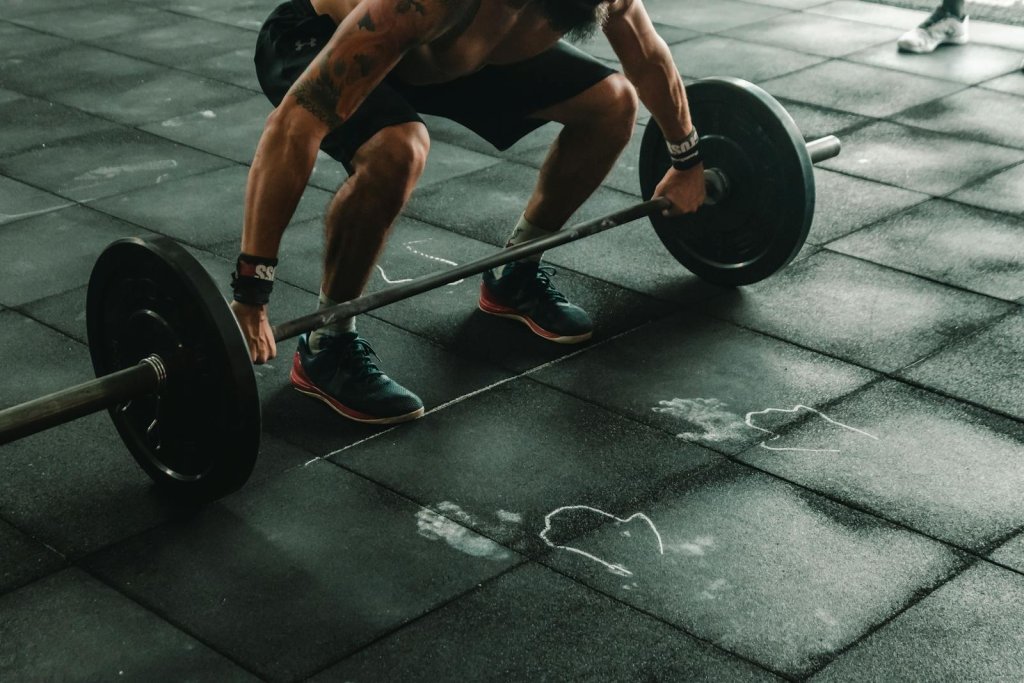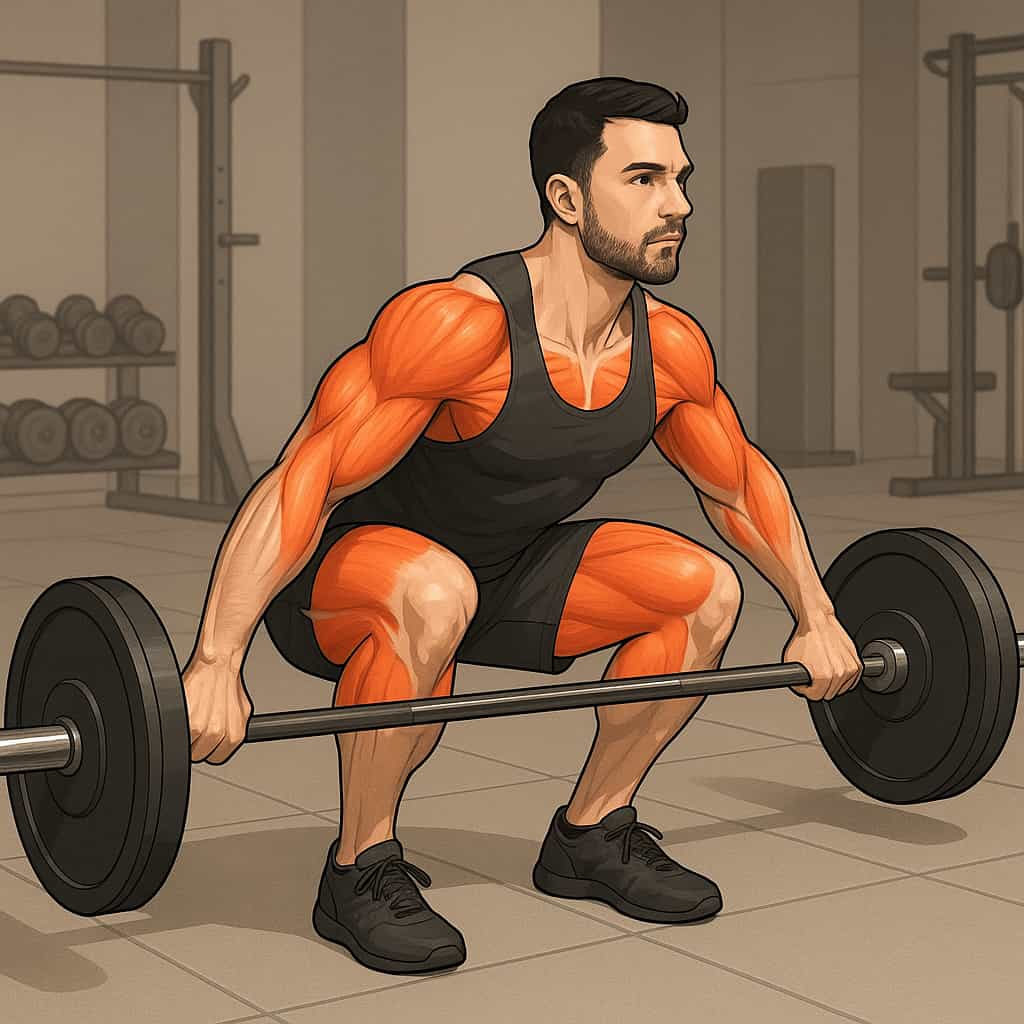The snatch grip deadlift is one of the most powerful exercises for building strength, muscle size, and athletic performance. Unlike the conventional deadlift, this variation uses a much wider grip on the barbell, forcing you into a deeper pulling position and activating more muscle groups across your body.

What makes it so effective? By demanding greater range of motion and stability, the snatch grip deadlift develops a stronger posterior chain, improves Olympic lifting mechanics, and builds a back that’s both powerful and resilient.
In this guide, we’ll break down five key benefits of the snatch grip deadlift, explain the muscles it works, show you proper form, cover useful variations, highlight common mistakes to avoid, and share pro trainer tips—everything you need to master this powerhouse lift and maximize your training results.
What Is the Snatch Grip Deadlift?
The snatch grip deadlift is a deadlift variation performed with your hands placed much wider than shoulder-width, similar to the grip used in the Olympic snatch.
- Grip width: Hands near the outer knurling of the barbell.
- Starting position: Hips lower, torso more upright, chest over the bar.
- Range of motion: Greater than a conventional deadlift due to deeper setup.
This variation is commonly used by Olympic weightlifters, powerlifters, and athletes who want to improve strength, stability, and pulling mechanics.
Muscles Worked

The snatch grip deadlift targets multiple muscle groups, making it one of the most complete compound exercises:
- Posterior Chain: Glutes, hamstrings, and erector spinae (lower back)
- Upper Back: Trapezius, rhomboids, rear delts
- Core: Abdominals and obliques for stability
- Grip & Forearms: Due to the wide hand placement
- Quadriceps: Heavily involved in the initial drive from the floor
5 Key Benefits of the Snatch Grip Deadlift

1. Builds a Strong Posterior Chain
The wide grip and deeper pull force you to engage the glutes, hamstrings, and lower back more than in a conventional deadlift.
- EMG studies show higher activation in the hamstrings and glutes when pulling from deeper positions (Journal of Strength & Conditioning Research, 2023).
- It’s a hybrid between a deficit deadlift and a conventional pull, making it an excellent accessory for strength and hypertrophy.
Trainer Tip: Keep your chest up and drive through the heels to fully recruit the posterior chain.
2. Improves Upper Back Strength and Posture
Because of the wider grip, the bar is further from your center of mass. This creates greater demand on the traps, rhomboids, and lats to stabilize the bar.
- Builds a thicker upper back, similar to heavy rows or shrugs.
- Improves thoracic extension, which translates into better posture under heavy loads.
- Reinforces the “shoulders back and tight” cue critical for both Olympic and powerlifting movements.
Real-world benefit: Many lifters report better posture and less rounding when returning to conventional deadlifts after a block of snatch grip work.
3. Increases Range of Motion and Hip Mobility
Since you must grip the bar wider, your body is forced into a deeper setup position, similar to pulling from a deficit.
- Improves mobility in the hips, ankles, and thoracic spine.
- Encourages a controlled, patient pull off the floor, teaching better bar path and timing.
- Helps athletes develop explosiveness and stability from awkward positions.
This makes it a powerful accessory for lifters who struggle breaking the bar off the floor.
4. Enhances Grip Strength
The wide grip challenges your forearms and grip endurance. Unlike conventional deadlifts where straps are often used, the snatch grip forces you to rely on raw grip power.
- Builds crushing grip strength for other lifts like rows, pull-ups, and even farmer’s carries.
- Improves bar control, especially for Olympic lifters who need a solid hold in the snatch.
- Can be performed without straps for maximum grip development, or with straps if the goal is heavier posterior chain work.
5. Direct Carryover to Olympic Lifts
For weightlifters, the snatch grip deadlift is one of the best assistance lifts.
- Mimics the snatch pull mechanics, reinforcing posture and timing.
- Strengthens the exact muscles used during the first pull of the snatch.
- Builds confidence handling heavier weights than your full snatch, improving overall pulling power.
Even if you don’t compete in Olympic lifting, this transfer helps with explosiveness, balance, and bar speed in all pulling movements.
Proper Form: How to Do the Snatch Grip Deadlift
- Setup
- Place feet shoulder-width apart, barbell over mid-foot.
- Grip the bar with a wide, snatch-width grip (usually hands near the rings of the bar).
- Keep your chest up, lats tight, and back flat.
- Execution
- Drive through your legs while maintaining a neutral spine.
- Keep the bar close to your body as you extend hips and knees.
- Stand tall at lockout, squeezing your glutes.
- Return
- Lower the bar under control by hinging at the hips.
- Reset and repeat for desired reps.
Trainer Tip: Use straps if grip becomes limiting, but also train without them to build grip strength.
Variations of the Snatch Grip Deadlift
1. Snatch Grip Deadlift from Blocks
How it Differs:
Instead of pulling from the floor, the barbell is elevated on blocks or safety pins. This reduces the range of motion (ROM).
Why it Works:
- Shorter pull allows lifters to overload the top range with heavier weights.
- Builds lockout strength and grip without overtaxing the lower back.
- Useful for Olympic lifters who need stronger second and third pull mechanics.
How to Do It:
- Place the bar on blocks or safety pins set just below or at the knees.
- Take a wide snatch grip and set up with a neutral spine.
- Pull the bar explosively to lockout while keeping shoulders engaged.
- Lower under control back to the blocks.
Trainer Tip: Focus on speed and bar path. Since the ROM is shorter, maximize bar acceleration to carry over to full snatch pulls.
2. Deficit Snatch Grip Deadlift
How it Differs:
You stand on a small platform (1–3 inches) to increase the pulling distance.
Why it Works:
- Forces you into a deeper starting position, increasing leg and hip drive.
- Builds power off the floor, helping both snatches and conventional deadlifts.
- Enhances mobility in the hips, hamstrings, and ankles.
How to Do It:
- Stand on a small platform or weight plates with a wide grip.
- Keep hips low, chest tall, and pull explosively from the floor.
- Drive through the quads, then transition to glutes and hamstrings.
Trainer Tip: Start with lighter weights. The increased ROM places greater stress on hamstrings and lower back—perfect form is key.
3. Pause Snatch Grip Deadlift
How it Differs:
You pause for 1–3 seconds at a specific point (often just below or above the knees).
Why it Works:
- Builds positional strength in weak areas.
- Reinforces proper pulling mechanics and bar path.
- Teaches patience off the floor instead of rushing the lift.
How to Do It:
- Begin with a wide grip and start the pull.
- Pause when the bar reaches shin height or just above knees.
- Hold tight—don’t let your back round or hips shoot up.
- Finish the lift after the pause, then lower under control.
Trainer Tip: Keep the pause honest—no bouncing or rushing. Use 60–70% of your max to maintain strict form.
4. Tempo Snatch Grip Deadlift
How it Differs:
Performed with a deliberately slow eccentric (lowering phase), often 3–5 seconds.
Why it Works:
- Increases time under tension, improving hypertrophy and grip endurance.
- Builds technical awareness by forcing you to control the bar path.
- Strengthens stabilizers in the posterior chain.
How to Do It:
- Perform a normal snatch grip deadlift.
- On the way down, count 3–5 seconds, keeping lats and core braced.
- Reset and repeat.
Trainer Tip: Don’t go too heavy. Focus on maintaining tension—imagine “riding the bar down” rather than letting it drop.
🔥 Coach’s Note:
Snatch grip deadlift variations are advanced and highly effective for building pulling power, grip strength, and Olympic lifting carryover. Rotate them strategically into your training:
- Blocks for overload and lockout strength.
- Deficit for speed off the floor.
- Pause for technique reinforcement.
- Tempo for hypertrophy and control.
Common Mistakes to Avoid
- Rounding the Back – Increases injury risk; focus on thoracic extension.
- Letting the Bar Drift Away – Always keep the bar close to your shins and thighs.
- Incorrect Grip Width – Too narrow reduces benefit; too wide can strain shoulders.
- Rushing the Pull – Use controlled leg drive rather than jerking the bar.
Who Should Do the Snatch Grip Deadlift?
- Olympic Lifters – For better snatch and clean pulls.
- Powerlifters – To strengthen the off-the-floor portion of the deadlift.
- Athletes – Builds explosive hip drive for sports performance.
- Bodybuilders – Develops traps, lats, and posterior chain thickness.
Not Recommended For: Beginners with poor mobility or lifters with existing shoulder or lower-back injuries.
Trainer Tips for Success
- Warm up with mobility drills for hips and shoulders.
- Use straps for high-volume work but train raw grip for max strength.
- Start light—this variation is harder than the conventional deadlift.
- Incorporate 2–4 sets of 3–6 reps into your program once per week.
FAQs About Snatch Grip Deadlifts
1. Is the snatch grip deadlift harder than a conventional deadlift?
Yes, the wider grip increases the range of motion, making it more challenging and effective for strength and mobility.
2. How wide should my hands be on the bar?
Typically, wide enough that the bar rests in your hip crease when standing tall. Many use the barbell’s outer rings as a guide.
3. Should I use straps for snatch grip deadlifts?
Yes, especially for higher reps or heavy sets. However, training without straps occasionally will build grip strength.
4. Can beginners do snatch grip deadlifts?
It’s best for intermediate to advanced lifters. Beginners should first master the conventional deadlift.
5. What’s the difference between a snatch grip and deficit deadlift?
Both increase range of motion, but the snatch grip emphasizes upper back engagement, while the deficit emphasizes leg drive.
6. How often should I do them?
Once per week is ideal as an accessory lift.
7. Does it build muscle or strength better?
Both—this lift builds massive posterior chain strength while adding size to the traps, lats, and glutes.
Conclusion
The snatch grip deadlift is more than just a strength move—it’s a complete builder for mobility, grip, power, and performance. By increasing range of motion, strengthening your upper back, and mimicking Olympic lifting mechanics, it’s one of the most versatile tools you can add to your program.
If you’re serious about getting stronger, improving your technique, or building a powerful physique, make the snatch grip deadlift part of your weekly training.
